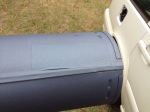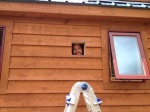Living in Michigan’s Upper Peninsula means 6-8 months of winter; we’ve had winter show up in October and not leave until May. There are quite a few options for heating a tiny house and each option has its pros and cons. When it came to heating our tiny house, our first thought was to heat with the Newport Dickinson propane fireplace. This is the stainless steel wall mounted direct vent heater that you see in so many tiny houses. We liked the clean stainless steel look and the glass window that revealed the flame. What we didn’t like about the Dickinson was that it is either on or off, and on high or low. We didn’t realize it at the time we made our decision, but because we have a propane refrigerator, it is imperative that we be able to keep the ambient temperature above 61 degrees or the fridge will go to freezing temperatures (apparently that’s just the way propane fridges work). With the Dickinson, we would have had to keep it running at all times.
Prior to buying our property we wanted to put in electric in-floor heat; however, once we found our property, we knew we were going to be off grid for a while. This ruled out all electric heat options. That left us with propane or wood. We looked at other wall mounted direct vent propane heaters, but I found most of them to be very unattractive and they also needed a certain wall depth that we didn’t have with our 2×4 walls.
The property we purchased has about 20 acres of woods, so heating with wood would be the most cost-effective heating method because it would be free if you don’t count the cost of our time cutting, chopping, and hauling wood. However, a wood fireplace has many drawbacks in such a small space. First and foremost, you can’t keep the house at a certain temperature. This would mean coming home after work to an extremely cold house. Also, because the house is so tiny, it would require an equally tiny wood stove. While tiny wood stoves do exist, keeping a fire burning throughout the night in such a small wood stove would not be possible, leaving us with either waking up to a cold house or getting up in the middle of the night to stoke the fire. We’ve lived in a house that we heated with wood and even with its large cast iron fireplace, we still often woke up in the morning having to re-start a fire. I also wasn’t too keen on the mess associated with wood heat. In a “normal” sized house, there is space for a large hearth with wood and kindling storage, but in the tiny house it would be difficult to keep ashes contained and store everything necessary with wood heat.
It became very clear that the best option for us would be to heat with propane, but we still had to find the right heater. In searching for heaters I came across a blog post all about heating tiny houses. In that post was a link to the Mini Franklin stove from the Woodstock Soapstone Company. The website claimed that the Mini Franklin would heat a space 100-400 square feet. We also found it to be very attractive, featuring a glass window to view the flame and cast iron and soapstone construction. What we liked even more was that we could add on a thermostatically controlled remote control giving us the ability to set the temperature or program the stove to a heating schedule.
We decided that this would be our stove of choice and began planning for its placement in the tiny house. We couldn’t afford to buy the stove at that time so we looked at the installation manual, made the necessary measurements, and located the place on the wall where the stove-pipe would vent to the outside of the house. We were required to frame in the opening on the wall where the pipe would go out and we installed our tongue and groove everywhere else. When we were finally able to purchase the stove we realized that our measurements apparently didn’t take into account the added hight due to the bend in 90 degree pipe elbows and our opening was 1-2 inches too low. We had to cut away some of the tongue and groove cedar and cut out the 2×4 that framed the opening and install it higher. We’ve had far worse goof ups so while this was inconvenient, it really wasn’t that difficult a fix.
There was some trial and error when installing the stove-pipe but eventually it all came together and we couldn’t be happier with our choice. The stove was installed at the end of September and just prior to installation we were experiencing some rather cold nights. We were able to set the thermostat to 62 degrees and the stove would kick on as needed. We found during that first month of having the stove that it didn’t really need to kick on very often. The propane fridge that we have (a post on the cook stove and propane fridge will come eventually) kicks out quite a bit of heat and during the fall it was almost heating the tiny house on its own, with the fireplace only kicking on at night. Now that winter is officially here (we have already had up to 4 feet of snow fall) the fireplace is on fairly consistently but has done a great job heating the tiny house. Most of the time, we just keep the house at 62 degrees, but the fireplace has no problem bringing the house temperature up to 70 degrees if we crank the heat. It’s too soon to tell how much propane we will go through, but we purchased two 100 pound propane tanks and have gone through two tanks since the end of September (the first tank lasted 6 weeks; the second tank lasted 3 weeks). We have a local farm store nearby that currently charges $82 to fill a 100 pound tank. We figure, at the most, we would go through two tanks a month in the winter, leaving us with a gas bill of $164/month. It’s quite likely that propane prices will go up throughout the winter, but with that being our only utility bill we don’t think that’s too bad.
The only complaint I had with the gas stove is how the company handles the painting of the stove-pipe. The pipe sections come with stickers labeling the type of pipe. The company either paints around the sticker or they put another sticker over the label and paint over the whole pipe. It looks terrible. Granted, I am a rather picky person. I formally complained to the company and they sent us a can of spray paint. I was able to peel off the stickers and repaint the sections. There was some sticker residue that was left behind but overall once I put a few coats of new paint on it wasn’t too noticeable.
I would definitely recommend the Mini Franklin to other tiny housers. It’s incredibly easy to light, looks very attractive, and keeps the house at very comfortable temperatures.















